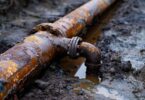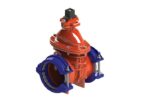As the need to strengthen water networks rises due to increasing urbanization and the impact of climate change, effective pressure management is becoming indispensable. Pressure regulating valves (PRVs), in particular, can combat non-revenue water by preventing unnecessary mechanical stress and improving the longevity of networks. However, traditional PRVs are often made of metal and need to be serviced frequently. The answer lies in modern materials, a simple construction, and digital functionality.
Every year, utilities worldwide lose 126 billion cubic meters of water and $39 billion in revenue. From a business point of view, this is classified as non-revenue water due to the discrepancy between the volume of water that is introduced into a water network and the volume that is actually billed to customers. Experts across the water sector agree that there are two major causes for this issue. On the one hand, utilities may experience commercial losses due to mismanagement. Problems include insufficient metering technology and billing data, but also corruption and theft. Physical losses, on the other hand, refer to problems within the network such as inadequate pressure management or the material and age of the pipes which can lead to leakages.
Lightweight, versatile, maintenance-free, and connected
While both commercial and physical losses must be addressed in the long-term, focusing on over-pressurized pipes is one of the most effective strategies to yield quick results. Studies have shown that reducing the pressure of water networks by 25% can cut water loss by up to 75%. Here, PRVs are the ideal solution.
On paper, they have a simple task: By facilitating precise pressure management, they bring complete balance into water networks. However, their components can cause headaches for operators. On the one hand, their mechanical construction tends to be quite complex, and they are often made of metal. Issues such as abrasion and corrosion lead to short maintenance intervals and therefore more labor and higher costs for utilities. Now, the newest generation of PRVs has overcome these challenges.
The benefits already begin with the choice of material: Polymers lower the overall weight, enabling an easier handling, installation, and maintenance. Additionally, their material properties result in components that are corrosion-free as well as long-lasting. At the same time, modern PRVs forego the complex construction of traditional models and instead feature an axial flow design. This leads to a PRV that is nearly maintenance-free and therefore highly cost-effective. Finally, modern PRVs offer digital functionality that allows operators to monitor a variety of parameters and further optimize their pressure management.
NeoFlow by GF Piping Systems
As a response to the current needs of the water sector, Swiss flow solutions provider GF Piping Systems has developed NeoFlow, the company’s newest pressure regulating valve. NeoFlow is designed to prevent over-pressurized pipes by ensuring an accurate and stable flow, as well as increased flow capacity. Thanks to its axial flow construction, the valve does not require an actuator stem or diaphragm and only consists of three primary components. Crucially, the valve is also less prone to cavitation damage. With a very compact polymer body, NeoFlow is corrosion-free and, in combination with its mechanical simplicity, has significantly longer maintenance intervals than metal alternatives. As the newest generation of PRV, the valve is also fitted with an integrated pilot valve that allows parameters such as flow and water quality to be monitored and controlled with additional equipment. Olivier Narbey, Senior Business Development Manager, Water Network Performance at GF Piping Systems, explains the importance of the product for the company: “The NeoFlow PRV provides water utilities with an easy entry into balanced pressure management and automated actuation, leading to a more sustainable distribution network, raising reliability, and simplifying the life of operators and installers of water networks worldwide. Combined with our campaign “Solving Water Loss for Life”, we want to raise awareness about non-revenue water and provide solutions that make a difference.”
Overcoming topographical constraints with NeoFlow
The district of Cochem-Zell is located in Rhineland Palatinate, Germany, and has around 60.000 residents. To provide them with potable water, the local network has a length of 1.400 kilometers and an annual flow volume of 4,2 million cubic meters. However, due to the proximity of the Mosel valley, the network is faced with large elevation changes between the main storage facility “Klausberg” and the city of Cochem. Potable water arrives with a pressure of 9 bar which is then then reduced to 1,5 bar with the help of PRVs. Additionally, the flow volume strongly fluctuates because of a winery and a golf resort in the area. Previously, the pressure regulating valves in the system were made of metal, however their internal components had to be laboriously serviced every two years, and they were susceptible to cavitation damage. The district water works Cochem-Zell therefore made the decision to replace their pressure regulating valves with NeoFlow.
Initially, the district waterworks Cochem-Zell and GF Piping Systems installed several data loggers throughout the network. They documented the pressure characteristics as well as flow rates and could therefore define the dimensions and settings of the new NeoFlow valves. The result was a trouble-free operation that is now perfectly adapted to the elevation changes and variable pressures. Thanks to the compact installation length, the previous DN150 metal valve could be replaced by two NeoFlow valves. Together, they progressively reduce the pressure from 9 bar to 1,5 bar – without cavitation damage.
A complete network overhaul in Australia
Mer Island in the Torres Strait at the very northern end of the Great Barrier Reef is home to 500 people. Previously, the community only had access to water for only 3 – 6 hours a day as the highly volatile network could not meet demand and was difficult to operate and maintain. As a result, losses were significant, and a proactive approach to preventing water loss was urgently required in order to scale up supply while meeting local logistical challenges. To achieve a rapid reduction in disruptions and establish an ongoing, reliable supply, the decision was made to overhaul the network.
NeoFlow pressure regulating valves were chosen to equip new pressure supply zones and could be installed by local operations teams following online training. The two new pressure supply zones formed a basis for advanced pressure controllers. Once the system was up and running, the network could immediately operate at the calibrated target pressure, with volatility a thing of the past. Within the next four to six weeks, levels at the rain-water catchment and water storage lagoons reached nearly 100%. Expensive and energy-hungry portable desalination units could be switched off. The community of Mer Island now has access to round-the-clock water for the first time in 20 years.







